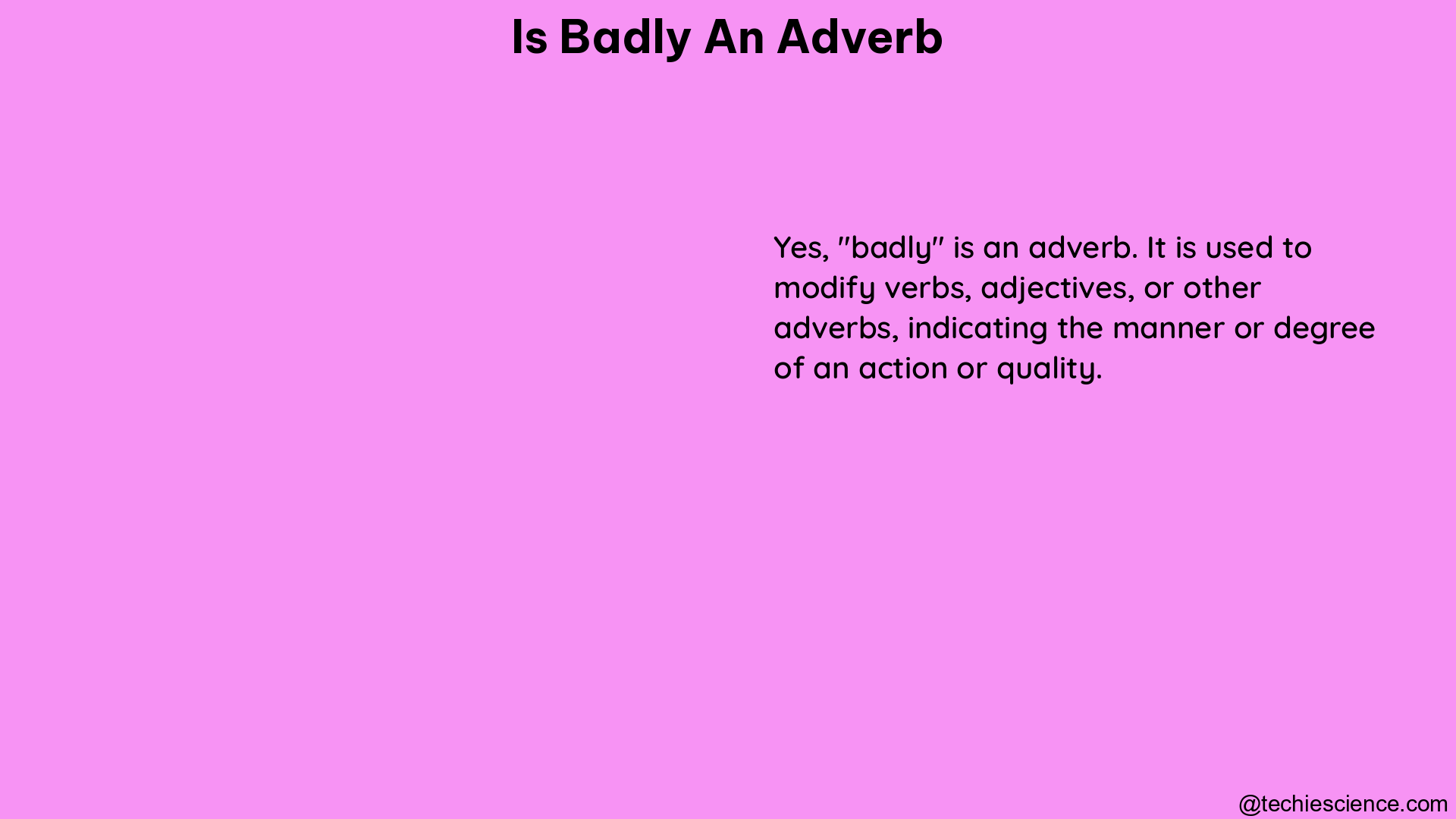Yes, “badly” is an adverb. It is used to modify verbs, indicating how an action is performed. For example, “She handled the news badly” (where “badly” describes the verb “handled”), and “He played badly” (where “badly” describes the verb “played”).
In contrast, “bad” is an adjective, used to describe nouns or pronouns. For instance, “The test was bad” (where “bad” describes the noun “test”), and “I feel bad” (where “bad” describes the state of the speaker).
Understanding the Difference Between “Bad” and “Badly”
Adjective vs. Adverb
The primary difference between “bad” and “badly” is their grammatical function. “Bad” is an adjective, while “badly” is an adverb.
Adjectives are used to describe nouns or pronouns, answering questions like “What kind?” or “Which one?” For example, “The bad weather ruined our picnic” or “I feel bad about missing the party.”
Adverbs, on the other hand, modify verbs, adjectives, or other adverbs, answering questions like “How?” or “In what way?” For example, “She played the piano badly” or “The team performed exceptionally well.”
Describing Feelings and Sensations
When describing feelings or sensations, “bad” is generally used as an adjective, while “badly” is used as an adverb.
- “I feel bad about missing the party.” (Adjective describing the feeling)
- “I feel badly about missing the party.” (Adverb describing how the person feels)
The first sentence, using “bad,” is more common and natural-sounding. The second sentence, using “badly,” suggests that the person’s ability to feel is impaired, which is not the intended meaning.
Describing Performance or Condition
“Bad” is used as an adjective to describe the quality or condition of something, while “badly” is used as an adverb to describe how something is performed.
- “The team played a bad game.” (Adjective describing the quality of the game)
- “The team played badly.” (Adverb describing how the team played)
In the first example, “bad” describes the overall quality or condition of the game. In the second example, “badly” describes the manner in which the team played.
Proper Usage of “Badly” as an Adverb

As an adverb, “badly” is used to modify verbs, adjectives, or other adverbs, indicating the degree or manner of an action.
Modifying Verbs
“Badly” is commonly used to modify verbs, describing how an action is performed:
- “She handled the news badly.”
- “He played the piano badly.”
- “The team performed badly in the game.”
In these examples, “badly” provides information about the manner in which the action (handling the news, playing the piano, performing) was carried out.
Modifying Adjectives
“Badly” can also be used to modify adjectives, describing the degree or intensity of a quality:
- “The weather was badly needed.”
- “The injury was badly bruised.”
- “The situation was badly managed.”
In these cases, “badly” intensifies the adjectives “needed,” “bruised,” and “managed,” indicating the degree or severity of the respective qualities.
Modifying Other Adverbs
“Badly” can be used to modify other adverbs, describing the manner or degree of an action:
- “The team played the game very badly.”
- “The singer sang the song incredibly badly.”
- “The student performed the task extremely badly.”
Here, “badly” is used to intensify the adverbs “very,” “incredibly,” and “extremely,” further emphasizing the manner in which the actions (playing, singing, performing) were carried out.
Examples of Proper “Badly” Usage
Here are some additional examples of “badly” used correctly as an adverb:
- “The storm hit the town badly, causing widespread damage.”
- “The candidate performed badly in the debate, failing to address the key issues.”
- “The patient was badly injured in the accident and required immediate medical attention.”
- “The company’s financial situation has been going badly, and they may have to file for bankruptcy.”
- “The students studied badly for the exam, and most of them failed.”
In each of these examples, “badly” is used to modify a verb, describing the manner or degree of the action.
Conclusion
In summary, “badly” is an adverb that is used to modify verbs, adjectives, and other adverbs, indicating how an action is performed or the degree of a quality. It is distinct from the adjective “bad,” which is used to describe nouns or pronouns. Understanding the proper usage of “bad” and “badly” is essential for effective and accurate communication in the English language.
References:
- https://www.grammarly.com/blog/bad-badly/
- https://www.grammarbook.com/blog/definitions/bad-vs-badly/
- https://www.merriam-webster.com/dictionary/badly
- https://owl.purdue.edu/owl/general_writing/academic_writing/essay_writing/distinguishing_between_bad_and_badly.html
- https://www.englishgrammar.org/bad-vs-badly/

Hi! I am Bhabesh Sing. I have completed M.A in English, M.A in Vocal Music, and B.Ed. I am a creative writer. Currently, I am a Subject Matter Expert in English on this Platform.
Let’s connect through LinkedIn-https://www.linkedin.com/in/bhabesh-sing-660914ab